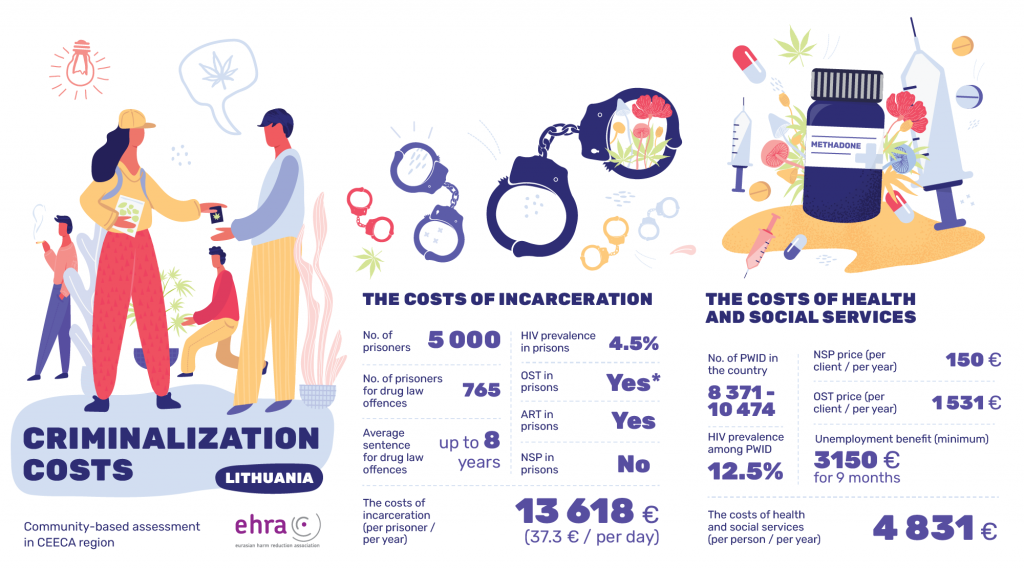
At the beginning of 2020, there were approximately 5,000 people incarcerated in the prisons of Lithuania, of which 765 were imprisoned for drug law offences (73 for the possession of drugs without the intent to distribute, and 692 for drug possession with intent to distribute) [1]. Terms of imprisonment can be for up to 2 years in the case of distribution without intent, and up to 15 years with intent; however, the average sentence in 2020 for drug law offences was 8 years, 6 months and 26 days in 2020 [2]. HIV prevalence among prisoners in 2017 was estimated at 4.5% [3] with antiretroviral therapy (ART) available in prisons [4]. Since 2018, opioid substitution therapy (OST) has been available in prisons but only for those inmates who were enrolled on an OST programme prior to their incarceration; in addition, health specialists can decide to terminate OST if they believe that the treatment is (a) not effective; and/or, (b) if the inmate uses mental or physical violence against prison staff; and/or, (c) if the inmate refuses to undertake a test for narcotic or psychotropic substances [5]. Needle/syringe programmes (NSP), however, are not available in Lithuanian prisons [6].
The Government of Lithuania spent €13,618 per year, or €37.31 per day, for each prisoner in 2020 [7].
In a study conducted during 2015 and 2016, there were estimated to be between 8,371 and 10,474 people who inject drugs and between 4,854 and 12,444 high-risk opioid users [8]. In 2014, the HIV prevalence among people who inject drugs was estimated at 12.5% [9]. The cost of NSP in 2015 was in the region of €150 per client, per year [10]. The cost of OST is €1,531 per client, per year, or €127.55 per month [11]. The average unemployment benefit in 2020 was approximately €350 per month for the first 5 months after a person has lost their job and is given for a maximum of 9 months. Unemployment benefit is only paid for those who have 12 months of work experience in the last 30 months and people need to have paid into their social insurance [12].
Therefore, it costs €4,831 per year to support a person who injects opioid drugs in community settings, whereas it costs €13,618 per year to incarcerate that person in prison. Consequently, by decriminalising drug use and/or possession, the Government of Lithuania could save itself €8,787 per drug user, per year, and potentially could save up to €6.7 million per year in total.
[1] Department of Prisons. Number, Composition of Convicted Sentences of Disposal (according to crime, age, term of penalty, etc.) and the statistical summary of their changes. Vilnius; Ministry of Justice, 2021. http://www.kaldep.lt/download/68170/nuteistuju%20skaiciaus,%20sudeties%20suvestine%202020s.xlsx (accessed 8 August 2021).
[2] Department of Prisons. Reports for 2020. Vilnius; Ministry of Justice, 2021. http://www.kaldep.lt/lt/kalejimu-departamentas/administracine_informacija/ataskaitos/metu.html (accessed 8 August 2021).
[3] Joint United Nations Programme on HIV and AIDS (UNAIDS). The Key Populations Atlas. Geneva; UNAIDS. https://kpatlas.unaids.org/dashboard (accessed 3 August 2021).
[4] Ministry of Health. Approval of the Description of the Procedure for the Diagnosis and Treatment of Human Immunodeficiency Virus Disease Reimbursed from the Budget of the Compulsory Health Insurance Fund. Vilnius; Ministry of Health, consolidated version, 23 July 2020 https://e-seimas.lrs.lt/portal/legalAct/lt/TAD/TAIS.371839/jcUnrcGxbi (accessed 8 August 2021).
[5] Department of Prisons. Order on the Approval of the Description of the Procedure for Ensuring Continuation of Opioid Dependence in Substitutional Treatment. Vilnius; Ministry of Justice, 25 April 2018. https://e-seimas.lrs.lt/portal/legalAct/lt/TAD/8945170248bf11e89197e1115e5dbece?jfwid=qjs00c7g2+Yes*+(the+regulations+on+OST+were+prepared+this+year+with+lots+of+barriers+to+get+or+to+%22loose%22+OST) (accessed 8 August 2021).
[6] Harm Reduction International (HRI). Global State of Harm Reduction 2020, Regional Overview 2.2 Eurasia. London; HRI, 2021. https://www.hri.global/files/2020/10/26/Global_State_HRI_2020_2_2_Eurasia_FA_WEB.pdf (accessed 3 August 2021).
[7] Department of Prisons. Reports for 2020, Ibid.
[8] Republican Centre for Addictive Disorders. Epidemiological Research to Estimate the Number of High Risk Drug Users in Lithuania. Prague; HA.REACT, 28 February 2018. https://www.rplc.lt/wp-content/uploads/2018/08/Lithuania_Research-Report_2018.pdf (accessed 8 August 2021).
[9] European Monitoring Centre for Drugs and Drug Addiction (EMCDDA). Lithuania Country Drug Report 2019. Luxembourg; Publications Office of the European Union, 2019. https://www.emcdda.europa.eu/system/files/publications/11341/lithuania-cdr-2019_0.pdf (accessed 8 August 2021).
[10] Širvinskienė A, Jakubauskienė M, Matuizaitė E. Recommendations for drug harm reduction service development and quality improvement in Lithuania. Vilnius; NGOs and coalition of experts “I can live”, 2015. http://galiugyventi.lt/wp-content/uploads/2015/12/INTERNETUI-Lietuva-national_report_LT_FINAL.pdf?fbclid=IwAR3OZAVmRJ3mJkwtboQOaQ9UAe_DpQT5v0u5qVl4LmPHYzS_pMOUs_BnlNQ (accessed 8 August 2021).
[11] Information submitted by the Republican Centre for Addictive Disorders, Vilnius.
[12] Board of the State Social Insurance Fund. Unemployment grimaces: one third of the unemployed had not worked in Lithuania before quarantine. Vilnius; Ministry of Social Security and Labour, 21 January 2021. https://www.sodra.lt/lt/naujienos/nedarbo-grimasos-trecdalis-bedarbiu-pries-karantina-nebuvo-dirbe-lietuvoje (accessed 8 August 2021).
